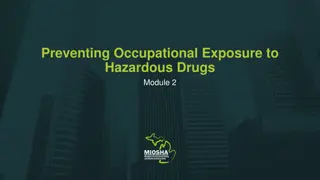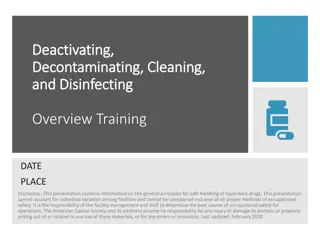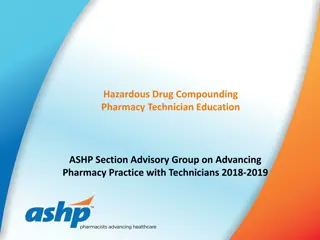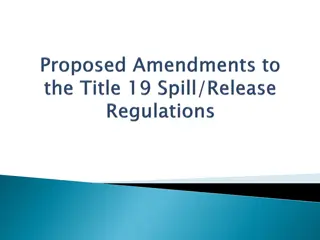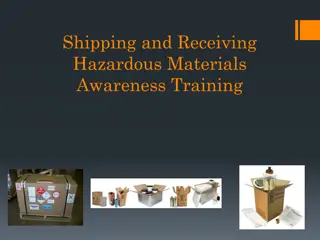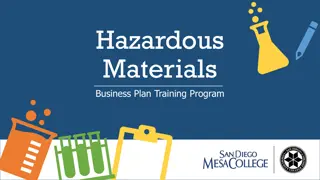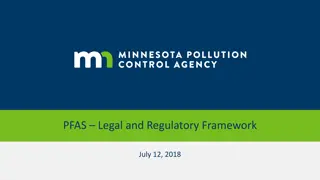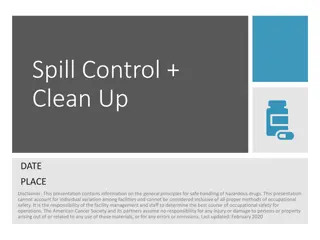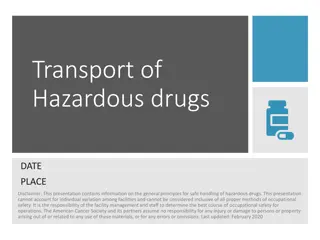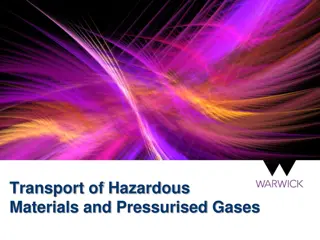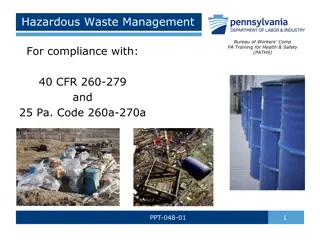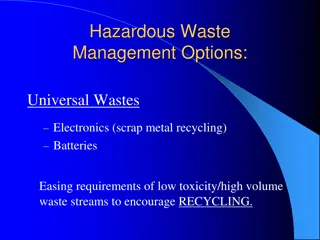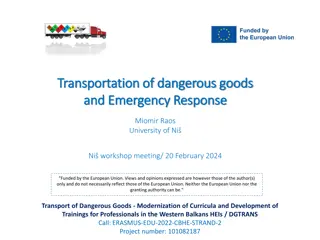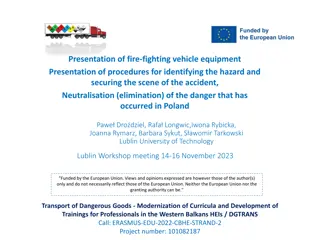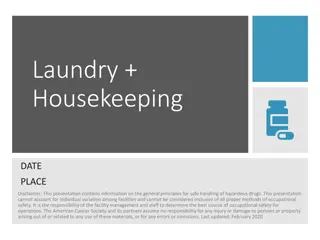Safe Handling of Hazardous Drugs: Training and Protocols
This presentation provides guidelines for the safe handling of hazardous drugs during receipt and unpacking. It covers topics such as personal protective equipment, inspecting packages for damage, and proper unpacking procedures. Staff involved in medication handling from suppliers should undergo this training to ensure occupational safety. The content emphasizes the importance of inspecting packages and unpacking hazardous drugs in the appropriate environments to prevent potential risks.
Download Presentation

Please find below an Image/Link to download the presentation.
The content on the website is provided AS IS for your information and personal use only. It may not be sold, licensed, or shared on other websites without obtaining consent from the author.If you encounter any issues during the download, it is possible that the publisher has removed the file from their server.
You are allowed to download the files provided on this website for personal or commercial use, subject to the condition that they are used lawfully. All files are the property of their respective owners.
The content on the website is provided AS IS for your information and personal use only. It may not be sold, licensed, or shared on other websites without obtaining consent from the author.
E N D
Presentation Transcript
Receiving Hazardous drugs DATE PLACE Disclaimer: This presentation contains information on the general principles for safe handling of hazardous drugs. This presentation cannot account for individual variation among facilities and cannot be considered inclusive of all proper methods of occupational safety. It is the responsibility of the facility management and staff to determine the best course of occupational safety for operations. The American Cancer Society and its partners assume no responsibility for any injury or damage to persons or property arising out of or related to any use of these materials, or for any errors or omissions. Last updated: February 2020
Any staff who handle medication package arrivals from suppliers. Who should take this training? Any staff who open and unpack medications. Staff may include facility administration and pharmacists. 2
Training Modules + Learning Objectives Preparation for receipt of HDs Distinguish the roles of staff who receive and unpack packages containing hazardous drugs (HDs) List the personal protective equipment (PPE) that receiving staff should have access to when opening packages containing hazardous drugs. Three-tiered approach to inspecting packages Demonstrate steps employee should take if an HD shipment has been damaged or broken. 3
Preparation for Receipt of Hazardous Drugs
Medications may arrive from the manufacturer with broken or cracked vials or packages. It has been well-documented that HD vials are shipped from manufacturers with trace amounts of drug on the external surface. Reference 1,2 5
Staff who handle packages must therefore inspect the packages to determine if there is any evidence of damage before unpacking. 6 Reference 1,2
Dos and Don'ts HDs should be unpacked in an area that is neutral/normal or negative pressure relative to the surrounding areas. HDs must not be unpacked from their external shipping containers in sterile compounding areas or in positive pressure areas. Reference 2,6 7
Access to Personal Access to Personal Protective Equipment Protective Equipment Chemotherapy- tested gloves An N95 respirator All personnel who receive HDs from manufacturers or distributors should be trained to wear full PPE and how to use a respirator. Disposable Gown Goggles Spill Kit 8 Reference 2
2 Three-Tiered Approach to Inspecting Packages
Tier I Tier I Visual examination of the shipping container for signs of damage or breakage. Check for signs of damage or breakage Check Labeling Example: Visible stains from leakage, sounds of broken glass. Packaging of HDs should be properly labeled by the manufacturer or distributor. Put on Gloves Wear one or two pairs of gloves that have been tested and approved for use with hazardous chemotherapy drugs. 10 10 Reference 1,5,7
Tier 2 Tier 2 If Shipping container is damaged If Shipping container is damaged Double gloves, gown, eye protection, and respirator Don Appropriate PPE Clean up and remove the damaged drug containers and packaging Locate Spill Kit Determine whether the package will be sealed and returned to the supplier or whether it will be opened. Enact Facility Policies 11 Reference 2,4,5
Open or Send Back Shipping Container? Open or Send Back Shipping Container? If the facility has a containment primary engineering control (C-PEC) on site there is an option to open and contain the product. If the facility does not have a C-PEC on site, the package should be returned to the supplier. Reference 4,5 12
Seal & Transport to C-PEC Tier 3 Tier 3 If it is determined that the damaged package should be opened Seal the container in plastic or an impervious container and transport it to a C-PEC for non- sterile HD compounding. At C-PEC Place a plastic-backed preparation mat on the work surface of the C-PEC Open the package Reference 4,5
Remove usable items Wipe Tier 3 Tier 3 Continued Wipe the outside of the usable items with a disposable wipe Enclose the damaged item(s) Enclose the damaged item(s) in an impervious container, label the outside container as "Hazardous". Reference 4,5
Contact Contact the supplier for instructions Clean Tier 3 Tier 3 Continued Clean the C-PEC Discard Discard contaminated items Discard the mat and cleaning disposables as hazardous waste Reference 4,5
16 1. Polovich M, Olsen M, LeFebvre K. Chemotherapy and biotherapy guidelines and recommendations for practice. 4th ed. Oncology Nursing Society; 2014 2. Pan American Health Organization. Safe handling of hazardous chemotherapy drugs in limited-resource settings [Internet]. 2013. 3. American Society of Health-System Pharmacists. ASHP guidelines on handling hazardous drugs. American Journal of Health-System Pharmacy. 2006;63:1172 93. 4. US Pharmacopeia. USP General Chapter <800> Hazardous Drugs-Handling in Healthcare Settings [Internet]. 2017 [cited 2018 May 7]. References 5. United States Occupational Safety and Health Administration. Controlling Occupational Exposure to Hazardous Drugs [Internet]. [cited 2018 May 5]. 6. Polovich M, Olsen M, editors. Safe handling of hazardous drugs. Oncology Nursing Society; 2018 CDC - NIOSH Publications and Products - NIOSH Respirator Selection Logic 2004 (2005-100) [Internet]. [cited 2018 May 17]. 7. Chartier Y, Emanuel, Jorge, Pieper, Ute, Pruss, Annette, Rushbrook, Philip, Stringer, Ruth, et al., editors. Safe management of wastes from health-care activities [Internet]. 2nd ed. World Health Organization; [cited 2018 Apr 13].



